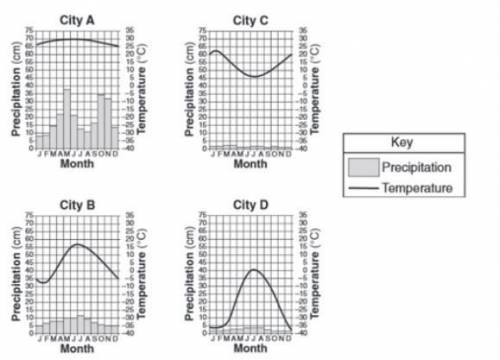
Geography, 16.02.2021 22:10, stormserena
Will give brainliest
Use the climographs below to answer the next three questions..
( 1 ) What would be the most likely reason for City A to have relatively steady temperatures throughout the year?
A) City A is located near the Great Lakes
B) City A is located far south in the southern hemisphere
C) City A is located near the equator
( 2 ) Compared to the climate at location A, the climate at location D is _.
A) cooler and drier
B) cooler and wetter
C) warmer and drier
( 3 ) City B is located in the Northern Hemisphere. How can you tell
A) Has similar monthly averages of precipitation
B) Has varying monthly averages of precipitation
C) Has the warmest average temperatures in July and August


Answers: 3
Other questions on the subject: Geography

Geography, 22.06.2019 10:30, chloerodgers56
Need now! 45 points laboratory: weather map interpretation i need someone to answer the other two questions. i will give to the best answer!
Answers: 2

Geography, 23.06.2019 16:20, Graciesett4072
Chris lives in a city that experiences heavy rainfall with average annual precipitation of 882 millimeters. it is warm all year. mark lives in city with an average annual rainfall of 40 millimeters. it has hot summers and cool winters. chris's city is in a climate, while mark's city is in a climate.
Answers: 1

Geography, 23.06.2019 20:00, brownboimexican
Scientist: cross-sections of stalactites—calcite formations deposited on cave ceilings by seeping water—can reveal annual variations in rainfall in particular areas over hundreds and thousands of years. we often found that when—according to these cross-sections—drought occurred in a particular area, it coincided with the collapse of an ancient society in that area. i hypothesize that drought reduced agricultural productivity in these areas, thereby leaving these societies without the resources needed to handle internal stresses and external threats. which of the following, if true, would most weaken the support for the scientist's hypothesis? a. many droughts indicated in the cross-sections of stalactites do not correspond with the collapse of a society in that area. b. information from the cross-sections of stalactites alone cannot reveal the level of agricultural output in an area at a particular time. c. most of the societies that collapsed during droughts did so when internal power struggles coincided with military raids from neighboring societies. d. most of the societies that collapsed during droughts maintained large stockpiles of food and water at the time of their collapse. e. information from stalactites also suggests that the collapse of some societies coincided with periods of abnormally high rainfall.
Answers: 1
Do you know the correct answer?
Will give brainliest
Use the climographs below to answer the next three questions..
( 1...
( 1...
Questions in other subjects:

Computers and Technology, 11.04.2021 21:40

History, 11.04.2021 21:40




Computers and Technology, 11.04.2021 21:40

Mathematics, 11.04.2021 21:40

Biology, 11.04.2021 21:40


Social Studies, 11.04.2021 21:40






